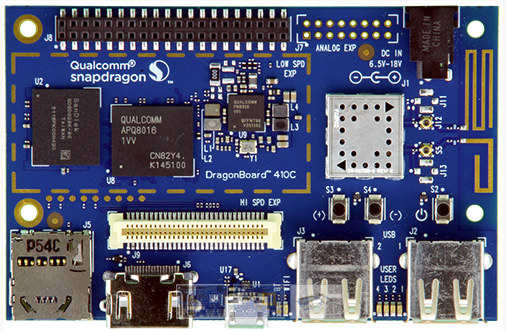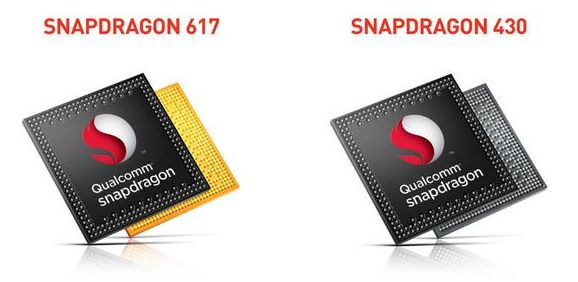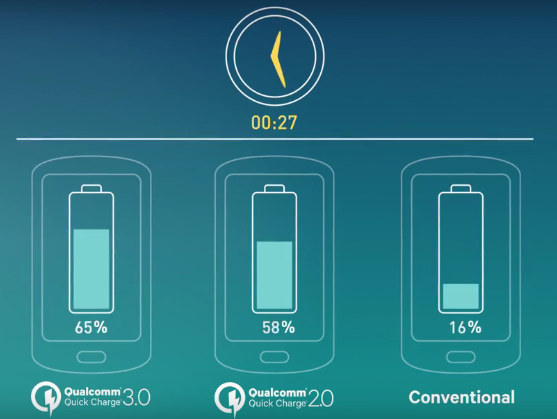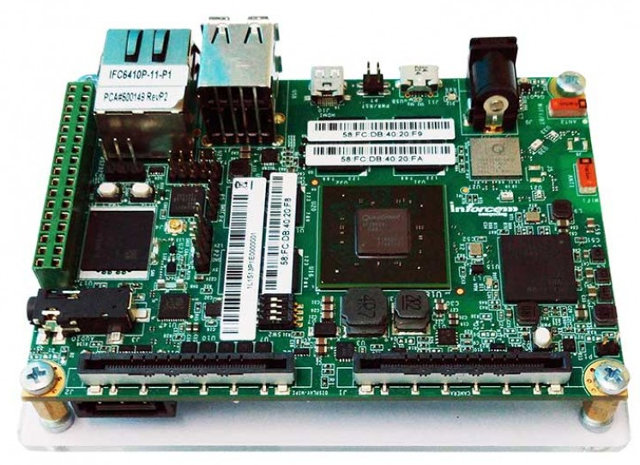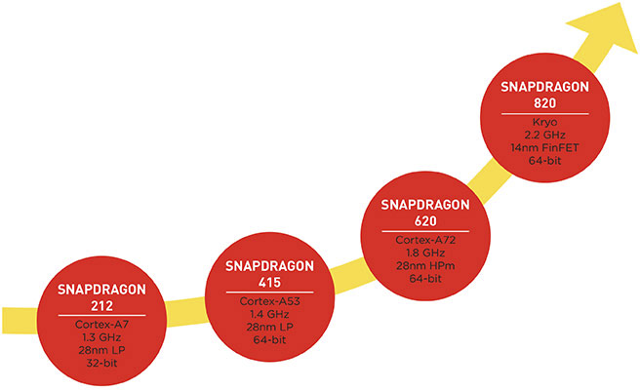Microsoft announced Windows 10 IoT Core for Raspberry Pi 2 and Minnowboard MAX boards a few months, and now the company has added a new ARM board to their Windows 10 IoT program with the soon-to-be-available Qualcomm DragonBoard 410c development board compliant with 96Boards specifications. Windows 10 IoT Core for DragonBoard 410c adds support for onboard WiFi and Bluetooth, as well as DirectX graphics on top of features already supported on the Raspberry Pi 2. To get started, you’ll need a computer running Windows 10, and follow DragonBoard’s Winfows 10 IoT Core guide. I assume most people familiar with Linux operating systems won’t suddenly jump ship to run a Windows operating systems, but Windows developers who got used to work with Visual Studio may be more comfortable with Microsoft’s environment. Out of curiosity, I’ve checked out if anybody had done any project with Windows 10 IoT core, and was surprised […]
Qualcomm Unveils Octa-core Cortex A53 Snapdragon 430 and 617 Processors
Qualcomm has unveiled two new octacore 64-bit ARM processors for mid-range smartphones with Snapdragon 430 and Snapdragon 617 Cortex A53 SoCs, both of which support the recently announced Quick Charge 3.0 standard and embed LTE connectivity. Snapdragon 430 Snapdragon 430 key features and specifications: CPU – 8x ARM Cortex A53 up to 1.2 GHz GPU – Qualcomm Adreno 505 GPU supporting up to OpenGL ES 3.1+ DSP – Qualcomm Hexagon 536 DSP Memory – LPDDR3 800MHz Storage – eMMC 5.1, SD 3.0 (UHS-I) Modem – Snapdragon X6 LTE – LTE Cat 4 (up to 150 Mbps DL/75 Mbps UL) Wireless Connectivity – WiFi 802.11n/ac (Qualcomm VIVE 2-stream with MU-MIMO), Bluetooth 4.1 + BLE, GPS (Qualcomm IZat Gen8C) Display – Up to 1080p on device and output Video – Up to 1080p at 30 FPS; Codecs: H.264 (AVC), H.265 (HEVC) Audio – Fluence HD noise cancellation technology Camera – Up to […]
Qualcomm Quick Charge 3.0 Promises to Charge Phones About 3x Faster Than Conventional Devices
Qualcomm has recently announced the latest version of its Quick Charge technology that allows to charge supported smartphones much faster than typical smartphones using a 5V charger. The company claims that Quick Charge 3.0 enabled smartphones can typicallly charge from zero to 80 percent in about 35 minutes compared to almost 90 minutes with conventional devices. Quick Charge 3.0 adds support for Intelligent Negotiation for Optimum Voltage (INOV), a new algorithm developed by Qualcomm Technologies that allows mobile devices to request optimal power transfer (3.6V to 20V in 200mV increments), while maximizing efficiency, which – together with other improvements – increases power efficient by 38% compared to Quick Charge 2.0, and allows charging the device twice as fast as possible with Quick Charge 1.0. That means the voltage and amperage will change during charging between 3.6V to 20V by 200mV increments, instead of 5V, 9V, 12V, and 20V for QC […]
Inforce 6410Plus Single Board Computer with Snapdragon 600 SoC Sells for $98 (Promo)
Inforce 6410Plus SBC is the successor of Inforce 6410 board, also based on Qualcomm Snapdragon 600 processor (APQ8064), but compared to the first version of the board, it adds GPS/Glonass, some MIPI CSI and DSI interface,and a few others changes. The normal price is $143, but it is currently selling for $98 for a limited period. I’ve reproduced the specifications below as a reminder: SoC – Qualcomm Snapdragon 600 (APQ8064) Quad Core Krait 300 processor @ 1.7GHz + Adreno 320 GPU System Memory – 2GB on-board PCDDR3, up to 533MHz Storage – 4GB eMMC + μSD card connector + SATA interface Connectivity: 802.11 b/g/n WiFi (Atheros QCA6234) Bluetooth 4.0 (Atheros QCA6234) 10/100/1000bps Ethernet (Atheros 8151) GPS/GLONASS Video and Audio Interfaces: μHDMI (1080p) 2x MIPI-CSI2 (4-lane, up to 20MP camera @ 15 fps) Dual MIPI-DSI (4 lane) – Primary : up to QWXGA (2048 × 1536), 60 Hz refresh rate; Secondary: […]
Qualcomm Snapdragon 820 Promises Twice the Performance & Power Efficiency of Snapdragon 810
Qualcomm has provided more details about Snapdragon 820 processor featuring custom-designed 64-bit ARM Kryo cores, an Adreno 530 GPU and an Hexagan 680 DSP, with claims that it should be twice as fast and consume half the power of Snapdragon 810 processor with Cortex A57 and A53 cores. Based on the chart below, it will also be faster than Snapdragon 620 with Cortex A72 and A53 cores. Snapdragon 820 will feature four Kryo cores (succeeding Krait cores) clocked at up to 2.2 GHz and be manufactured using 14nm FinFET process technology. Adreno 530 GPU is expected to deliver over 40% performance improvement over Adreno 430 GPU while also keeping power consumption 40% lower, a new Spectra camera dual ISP will support 14-bit sensors, and Hexagon 680 DSP adds a separate low power DSP for always-on sensor processing, and support for HVX (Hexagon Vector eXtensions) to be used for advanced imaging […]
Linux 4.2 Release – Main Changes, ARM and MIPS Architectures
Linus Torvalds released Linux Kernel 4.2 last Sunday: So judging by how little happened this week, it wouldn’t have been a mistake to release 4.2 last week after all, but hey, there’s certainly a few fixes here, and it’s not like delaying 4.2 for a week should have caused any problems either. So here it is, and the merge window for 4.3 is now open. I already have a few pending early pull requests, but as usual I’ll start processing them tomorrow and give the release some time to actually sit. The shortlog from rc8 is tiny, and appended. The patch is pretty tiny too. Go get it, Linus Some notable changes made to Linux 4.2 include: File systems New features for F2FS including per file encryption CIFS support SMB 3.1.1 (experimental) Cryptography – Jitter Entropy Random Number Generator, Chacha20 stream cipher and Poly1305 authentication (RFC7539),New RSA implementation. See lwn.net […]
Linaro 15.07 Release with Linux 4.2 and Android 5.1
Linaro 15.07 has been released with Linux 4.2-rc3 (Baseline), Linux 3.10.83, 3.14.45 and 3.18.17 (LSK), and Android 5.1.1_r8. The Linux kernel got various bug fixes, and a power reduction technique has been implemented for Qualcomm processor. Progress has been made to boot Android with UEFI on Hikey board, and work is still on-going on 96boards including Hisilicon Hikey, Qualcomm DragonBoard 410c, and an upcoming and yet-to-be-formally-announced Marvell PXA1928 board called Helium. Highlights of this release: Linux Linaro 4.2-rc3-2015.07 linaro-android topic updated to 4.2-rc3 and recent AOSP/android-3.18 included GATOR version 5.21.1 llct-misc-fixes topic: “HACK: of: Limit FDT size for CRC check on arm64” has been dropped. FVP model was the last target to require this hack, but the new FVP firmware doesn’t need it anymore updated integration-linaro-vexpress64 topic by ARM LT: Versatile Express TC2 support is back, HDLCD display now works on TC2, the topic will be renamed to integration-linaro-vexpress next […]
Qualcomm Dragonboard 410c is Another 96Boards Compliant 64-bit ARM Development Board
Linaro announced the 96Boards initiative at Linaro Connect Hong Kong last month, and in collarabation with Huawei announced Hikey development board following this new standard. Qualcomm has now joined the Fray with Dragonboard 410c, a 96Boards board powered by Qualcomm Snapdragon 410 quad core Cortex A53 processor. Dragonboard 410c specifications: SoC- Qualcomm Snapdragon 410 (APQ8016) quad-core ARM CortexA53 @ 1.2 GHz with Adreno 306 GPU @ 400MHz System Memory – LPDDR2/3 533MHz, Single-channel 32-bit (4.2GBps) Storage – eMMC 4.51 + micro SD 3.0 (UHS-I) Video Output – HDMI up to 1080p Connectivity – Integrated 802.11 b/g/n, BT/FM, GPS USB – 2x USB 2.0 host ports, 1x micro USB OTG port. Camera – Support for 13 MP camera with Wavelet Noise Reduction, JPEG decoder, and other post-processing techniques done in hardware Expansion: 1x 40 pin low speed expansion connector – UART, SPI, I2S, I2C x2, GPIO x12, DC power 1x 60 […]


